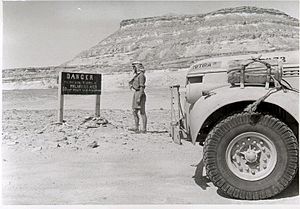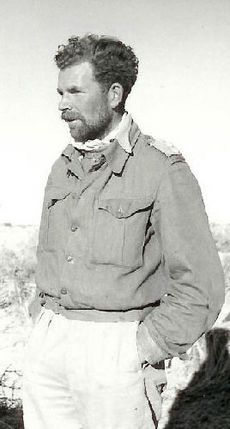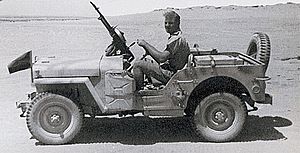Operation Caravan facts for kids
Quick facts for kids Operation Caravan |
|||||||
|---|---|---|---|---|---|---|---|
| Part of Operation Agreement, during the Second World War | |||||||
 Tutira III of T1 Patrol was driven by Captain Nick Wilder during the attack on Barce's airfield. |
|||||||
|
|||||||
| Belligerents | |||||||
| Strength | |||||||
| 47 | Unknown | ||||||
| Casualties and losses | |||||||
| Wounded: 8 Captured: 10 Missing: 2 Senussi of the Libyan Arab Force fate unknown. Vehicles destroyed: - 10 x 30cwt Chevrolets - 4 x Willys Jeeps |
Killed: 4 Wounded:15 Captured: 1 Aircraft destroyed: 16 Aircraft damaged: 7 Also Destroyed/damaged: Motorised Transport, military equipment, buildings (described in text). |
||||||
Operation Caravan was a secret mission during World War II. It was part of a bigger plan called Operation Agreement in September 1942. The goal was to attack important enemy locations at the same time.
There were four main attacks planned. These were against Tobruk, Benghazi, Jalo oasis, and Barce. Operation Caravan, which targeted Barce, was the only one that succeeded.
The Long Range Desert Group (LRDG) led the attack on Barce. Their main target was the Italian airfield there. The LRDG traveled a very long distance, about 1,850 kilometers (1,155 miles), to reach Barce. One part of the group attacked the airfield. They destroyed many enemy planes. Another part attacked the army barracks.
Contents
The Mission and Its Targets
In early September 1942, a special unit called 'B' Squadron began its mission. This unit was part of the LRDG. It had two smaller groups, known as half-patrols. Major John Richard Easonsmith was in charge.
Their orders were clear: "Cause the maximum amount of damage and disturbance to the enemy." They left their base in Egypt. Their destination was Barce, a town about 80 kilometers (50 miles) northeast of Benghazi.
Barce was a major center for the Italian government in Libya. There was a large airfield on the northeast side of the town. This airfield was the main target for the LRDG.
The force included 47 men. They had 12 Chevrolet trucks and five jeeps. Captain J. A. L. Timpson led the G1 patrol. Captain N. P. Wilder led the T1 patrol.
They were joined by Major Vladimir Peniakoff. He brought two Senussi tribesmen with him. These Senussi men were part of the Libyan Arab Force. They were supposed to gather information. They would get details about enemy positions from friends near Barce. Then, they would report back to Major Peniakoff before the raid.
Italian Defenses at Barce
The Italian forces in Barce were ready for a fight. They had a company of police. These police had AB.41 armored cars. There was also a company of Royal Carabinieri.
Other units included the 8th Blackshirts section. The 17th Machine-gun Battalion was also present. The 10th Light Tank Company had L3/35 tankettes. There was also an artillery group with large 12.7 cm guns.
At the Barce airfield, the 35th Bombing Wing was stationed. They flew Cant Z.1007bis bombers. The 131st Squadron had Caproni Ca.311 observation planes. Other cavalry and Libyan units were also in the area.
The Long Journey to Barce
The LRDG had to choose a special route. This was to avoid other military traffic. Their journey involved crossing the Sand Sea twice. The trip out was about 1,850 kilometers (1,150 miles).
The jeeps could travel about 1,448 kilometers (900 miles) on their own fuel. The Chevrolets could go about 2,414 kilometers (1,500 miles). So, two large Mack trucks helped them. These trucks carried extra fuel for the first 322 kilometers (200 miles). They got another refill after a week. This was from two more heavy trucks at a place called "Howard's Cairn."
On the third day, something went wrong. Captain Timpson's jeep flipped over a sand-dune. Captain Timpson and his driver were hurt. They had to be flown out by a Lockheed Hudson plane. Sergeant Jack Dennis then took command of the G1 Patrol.
The LRDG reached Benia on September 13. Benia was about 24 kilometers (15 miles) south of Barce. They set up camp on a hill among trees. The 1,858-kilometer (1,150-mile) journey had taken 11 days.
One truck was hidden at a secret meeting point. It had small supplies of food and water. The other trucks were hidden in the trees. The men prepared their weapons and explosives. Major Easonsmith held a final meeting at 3 pm. Major Peniakoff helped, as he knew the town's layout.
The T1 Patrol would attack the airfield. This was the main target. The G1 Patrol would create a distraction. They would attack the main barracks and the railway station.
The LRDG didn't know they had been seen. An Italian plane had spotted them. It dropped a message to a nearby cavalry base. General Piatti del Pozzo, the Italian commander, ordered air and ground searches. He also prepared for an attack.
At dusk, the force moved out. They cut telephone wires along the way. Near the town, a sentry challenged them. He was captured. Another officer was shot and killed. The nearby buildings were attacked with grenades.
During this, a T1 Patrol truck crashed. Its radiator was wrecked. The truck had to be left behind. Its crew joined other trucks. Another G1 Patrol vehicle was also damaged and abandoned.
The T1 Patrol's radio truck went to Sidi Selim. This was about 12 kilometers (7.5 miles) southeast of Barce. It would be a meeting point after the attack. It also had to listen for messages from another British unit.
By 11 pm, the patrols reached a main road. They drove with their headlights on. They pretended to be an enemy convoy. They saw two L3 tankettes guarding the road. The LRDG vehicles opened fire as they sped past. The tankettes were caught by surprise.
By midnight, the LRDG was at the crossroads outside Barce. The two patrols split up. Major Easonsmith and his two jeeps went around Barce. They looked for other targets. Major Peniakoff stayed at the crossroads. He would stop any attempts to block the LRDG's escape.
Attacking the Airfield
To reach the airfield, the T1 patrol drove around the east side of Barce. They used the main road. An Italian military unit passed them. They exchanged friendly greetings.
Near the airfield entrance, sentries challenged the patrol. They were shot down. The airfield gates were shut but unlocked. Captain Wilder opened them. The trucks drove onto the airfield.
The first target was a truck carrying aviation fuel. Machine gun fire turned it into a huge fireball. This lit up the airfield. It made it easier for the LRDG to see.
The Italians expected an attack. But they thought it would come from foot soldiers from the south. They didn't expect vehicles from the main road. So, the T1 patrol faced little resistance at first.
Next, they attacked the concrete administration building. This building also had the mess hall and barracks. Grenades were thrown inside, starting a fire. A hangar and other buildings were shot up. A fuel dump with many drums was destroyed.
On the airfield, the T1 patrol drove in a circle. They fired at parked bombers. They used special bullets that were tracer, incendiary, and explosive. The T1 Patrol had powerful machine guns. These included .303 Browning machine guns, .50-inch Vickers heavy machine guns, and .303 inch Vickers K machine guns.
Corporal Merlyn Craw had a special plan. He made small incendiary time-bombs. These were made from "Nobel's Gelignite." Craw and Yealands were in the last vehicle. They had a box full of these bombs.
When they found an aircraft that wasn't burning, they jumped out. They placed a bomb on a wing, above the fuel tanks. Corporal Craw lit the fuse. Both men then had to quickly dive to the ground as the aircraft exploded.
Corporal Craw later said:
I started off with 13 bombs and I had got rid of 11 of them. Despite what was going on all around me I was too busy doing my job to worry about fear...Of the two bombs left, one had a broken safety fuse. So we joined them together and placed them on a small single-engined plane [ a German Fieseler Storch in Italian service]...the small plane was blown to bits!
At least ten aircraft were destroyed this way. Craw and Yealands were not hurt at all.
The T1 patrol spent about an hour on the airfield. None of the New Zealand soldiers were hit. None of their vehicles were put out of action. The LRDG drivers were very skilled. They could drive fast, making their vehicles hard to hit. Their gunners were also very accurate.
Another reason they weren't hit much was the anti-aircraft guns. These guns were meant to shoot at planes in the sky. They couldn't fire horizontally along the ground.
Captain Wilder wrote a report after the attack. He said the Italians were "waiting for us, but they seemed to be very panicky and their fire was very wild."
Based on Wilder's report, the T1 patrol thought they had destroyed or damaged 32 aircraft. Most of these were bombers. Italian records later said 16 aircraft were destroyed and seven were damaged.
After the Attack
After the attacks, the two patrols met up. By then, they had lost ten men, three trucks, and a jeep.
Before dawn on September 14, the LRDG came under fire. This was near a police post south of Sidi Selim. Three men were injured. A truck was so damaged it had to be towed. This truck and two others damaged earlier were left behind. Their supplies were moved to other vehicles. Timed explosives were set to destroy them.
The force continued their journey back. Then another vehicle broke down. The enemy spotted the force and attacked them from the air. This continued until dusk. By then, all but one truck and two jeeps had been destroyed.
Ten members of the force started walking. They aimed for Bir el Gerrari. A vehicle had been left there. The force doctor took the remaining truck and a jeep with the wounded. They had to leave the jeep along the way. But they reached Bir el Gerrari on September 15. Then they found another LRDG patrol at a landing ground. The Royal Air Force (RAF) then flew the wounded to Kufra.
Another group of fourteen men also started walking. They carried their food and water on the other jeep. After about 130 kilometers (80 miles), on September 17, they met LRDG patrol S2. Searches found eight of the first walking party. The two missing members had fallen behind. They turned north, not expecting to reach the meeting point. On September 20, they found an Arab camp. The Italians captured them there. By then, these two men had walked over 240 kilometers (150 miles).
Another LRDG patrol (S1) picked up two more members. These men had walked out of Barce.
Many soldiers received awards for their bravery. Easonsmith and Wilder were given the DSO. Lawson received the Military Cross. Craw, Tippett, and Dobson were awarded the Military Medal.
Images for kids




